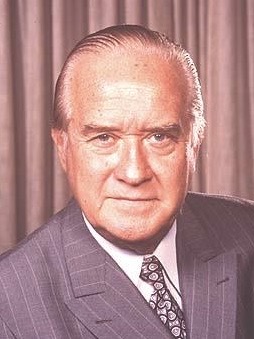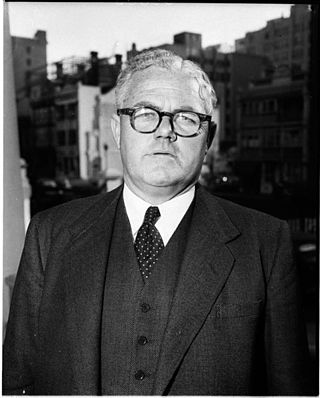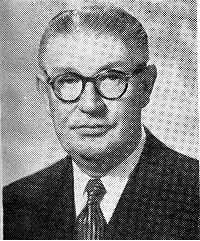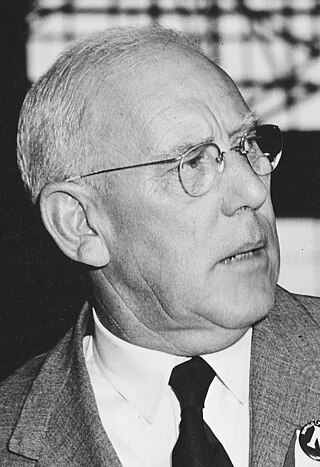
Sir Robert William Askin, GCMG, was an Australian politician and the 32nd Premier of New South Wales from 1965 to 1975, the first representing the Liberal Party. He was born in 1907 as Robin William Askin, but always disliked his first name and changed it by deed poll in 1971. Before being knighted in 1972, however, he was generally known as Bob Askin. Born in Sydney in 1907, Askin was educated at Sydney Technical High School. After serving as a bank officer and as a Sergeant in the Second World War, Askin joined the Liberal Party and was elected to the seat of Collaroy at the 1950 election.

Marrickville was an electoral district of the Legislative Assembly in the Australian state of New South Wales. It was an urban electorate in Sydney's inner west, centred on the suburb of Marrickville from which it took its name. At the time of its abolition it also included the suburbs of Camperdown, Darlington, Enmore, Lewisham, Newtown, Petersham, Stanmore and parts of Dulwich Hill and Erskineville as well as the University of Sydney.

James McGirr was an Australian politician. He served as premier of New South Wales from 1947 to 1952, holding office as leader of the Australian Labor Party (ALP). He led the party to victory at the 1947 and 1950 New South Wales state elections. He was a pharmacist by profession and the younger brother of Patrick and Greg McGirr, who were also members of parliament; Greg also led the ALP briefly but was never premier.

The 2007 New South Wales state election was held on Saturday, 24 March 2007. The entire Legislative Assembly and half of the Legislative Council was up for election. The Labor Party led by Morris Iemma won a fourth four-year term against the Liberal-National coalition led by Peter Debnam.

Lieutenant Colonel Sir Michael Frederick Bruxner was an Australian politician and soldier, serving for many years as leader of the Country Party in New South Wales. Born in the north of the state, Bruxner was educated at The Armidale School and started studies at University of Sydney but later dropped out to take up employment as a grazier and station agent in Tenterfield. After serving in the Citizen Military Forces from 1911, Bruxner enlisted into the Australian Light Horse upon the outbreak of the First World War in 1914. Serving with distinction in Gallipoli, Egypt and Palestine, he was promoted to lieutenant colonel and awarded the Distinguished Service Order.

Arthur Edward Greenup was a trade unionist and politician in New South Wales, Australia.
Members of the New South Wales Legislative Assembly who served in the 36th parliament held their seats from 1950 to 1953. They were elected at the 1950 state election, and at by-elections. The Speaker was Bill Lamb.
The Industrial Labor Party or Heffron Labor Party was a short-lived but influential political party active in New South Wales between 1936 and 1939. It was a splinter group of the Labor Party (ALP) and was formed by Bob Heffron after he and Carlo Lazzarini attempted to depose the party leader Jack Lang. Both Heffron and Lazzarini subsequently lost their party endorsements for the 1938 election.

Philip Henry (Pat) Morton was an Australian businessman and politician. Born in Lismore in Northern New South Wales to a prominent political family and educated at Lismore High School, Morton left school at fourteen to be employed in a legal firm, before branching out into various businesses. Moving to Sydney, Morton first entered politics in 1944 as an Alderman on Mosman Municipal Council, rising to be Mayor in 1946. Morton then entered the New South Wales Legislative Assembly on 3 May 1947, representing the Electoral district of Mosman for the Liberal Party.

Sir Vernon Haddon Treatt was an Australian lawyer, soldier, Rhodes Scholar and politician. Born in Singleton, New South Wales and educated at Shore School, Treatt interrupted his studies at the University of Sydney to enlist at the outbreak of the First World War. Serving in the Royal Australian Artillery, Treatt served in France and was awarded the Military Medal. Upon returning to Australia he was awarded a Rhodes scholarship and further educated at New College, Oxford.

The 1938 New South Wales state election was held on 26 March 1938. This election was for all of the 90 seats in the 32nd New South Wales Legislative Assembly and was conducted in single member constituencies with compulsory preferential voting.

Francis Joseph Finnan was an Australian politician and a member of the New South Wales Legislative Assembly from 1941 until 1953. He was a member of the Labor Party and held numerous ministerial positions between 1947 and 1953.

The 1950 New South Wales state election was held on 17 June 1950. It was conducted in single member constituencies with compulsory preferential voting and was held on boundaries created at a 1949 redistribution. The election was for all of the 94 seats in the Legislative Assembly, which was an increase of 4 seats since the previous election.

The 1947 New South Wales state election was held on 3 May 1947. It was conducted in single member constituencies with compulsory preferential voting and was held on boundaries created at a 1940 redistribution. The election was for all of the 90 seats in the Legislative Assembly.

The 1956 New South Wales state election was held on 3 March 1956. It was conducted in single member constituencies with compulsory preferential voting and was held on boundaries created at a 1952 redistribution. The election was for all of the 94 seats in the Legislative Assembly.

The 1962 New South Wales state election was held on 3 March 1962. It was conducted in single member constituencies with compulsory preferential voting and was held on boundaries created at a 1961 redistribution. The election was for all of the 94 seats in the Legislative Assembly.
This is a list of candidates of the 1953 New South Wales state election. The election was held on 14 February 1953.

The Cahill ministry (1952–1953) or First Cahill ministry was the 55th ministry of the New South Wales Government, and was led by the 29th Premier, Joe Cahill, of the Labor Party. The ministry was the first of four consecutive occasions when the Government was led by Cahill, as Premier.

The Cahill ministry (1953–1956) or Second Cahill ministry was the 56th ministry of the New South Wales Government, and was led by the 29th Premier, Joe Cahill, of the Labor Party. The ministry was the second of four consecutive occasions when the Government was led by Cahill as Premier.

The Cahill ministry (1959) or Fourth Cahill ministry was the 58th ministry of the New South Wales Government, and was led by the 29th Premier, Joe Cahill, of the Labor Party. The ministry was the fourth and final of four consecutive occasions when the Government was led by Cahill, as Premier.















